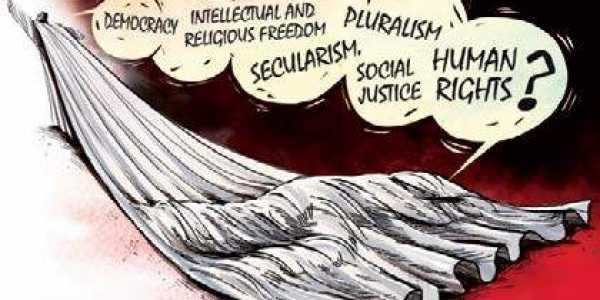
Two prominent bishops have said the Constitution is in danger. Before the Church preaches to others, it should first look inwards
By Balbir Punj
The recent past has seen two successive missives by the Christian clergy hitting the headlines. To sum it up, two bishops, one from Goa and another from Delhi, have made three points: the Constitution is under serious threat, pluralistic ethos are in danger and minorities (particularly Christians), Adivasis and Dalits are being persecuted.
The statements by the bishops do not refer to anyone by name. But it is not difficult to identify the implied target. Shorn of verbosity, the two letters are in fact a call to the faithful to actively work for the defeat of the BJP and Prime Minister Narendra Modi in the 2019 general elections.
The two letters are replete with words such as democracy, pluralism, intellectual and religious freedom, secularism, social justice and human rights. Those conversant with the Church’s record on these issues, in India and elsewhere, will find that these letters smack of hypocrisy and deceit.
The period between 1989 and 1991 witnessed the killing and persecution of Kashmiri Pandits in the Valley. Local Muslims motivated by Islamic zeal and encouraged by Pakistan (both in terms of arms and training) raped Pandit women and demolished their temples in dozens with impunity. It was not a case of isolated violence against an individual, a la Mohammed Akhlaq (Dadri 2015).
An entire community was forced to flee the land of its forefathers after suffering an enormous loss of self esteem, life and property. In February 2002, 59 Karsevaks were burnt alive in Godhra. Did all these tragedies touch the consciousness of the Church? Did it ever protest? Even the Jallianwala Bagh massacre of 13 April 1919 and subsequent police excesses on Indians in Punjab could not move the Church. It refrained from making any pronouncement on these sordid developments. And there were missionaries in India who justified British military action in Punjab!
Christianity’s first interaction with Hindu India took place about 1,600 years before the present Constitution came into being. Christians had become suspect in Iran from the fourth century onwards when Iran’s old adversary, the Roman Empire, became a Christian state. They fled their homeland and sought refuge on the Malabar coast.
Later on, they were joined by refugees from Syria and Armenia, escaping from Christian heresy-hunters. No Hindu, raja or commoner, ever bothered about what the refugees believed in or what God they worshipped. In due course, the refugees came to be known as Syrian Christians.
When did “intolerance” creep into the Hindu-Christian relationship? In 1542, Saint Francis Xavier landed in Goa with a mandate to discipline heretics and wage a war against ‘paganism and infidels’. In the following centuries, under the Portuguese regime, forced mass conversions and persecution of non-Christians became the norm.
Even the Syrian Christians in Kerala did not escape the missionary zeal of the Catholic Church. According to Dr B R Ambedkar, “the inquisitors of Goa discovered that they (Syrian Christians) were heretics and like a wolf on the fold, down came the delegates of the Pope upon the Syrian Churches”. (italicised words added)
Subsequently Don Alexis de Menezes was appointed the archbishop of Goa. In Dr Ambedkar’s words, “It was his mission less to make new converts than to reduce old ones to subjection, and he flung himself into work of persecution with an amount of zeal and heroism that must have greatly endeared him to Rome.”
It was the era when the newly-emerging Protestant faith (a sect of Christianity) and the Vatican were fighting an all-out war in Europe. Both were equally ruthless in dealing with people who were suspected of following a rival Church. Thanks to this intra-faith enmity, countless innocent Christians were burnt on stakes, skinned alive and tortured to death. The tormentors and the victims belonged to different sects of the same faith.
All this savagery was in the name of God and it lasted for several centuries. The Catholic Church is an inheritor of such a ‘proud’ legacy and still has the gumption to pontificate on noble values such as ‘tolerance and secularism’. India is secular, not because of its Constitution. Instead, the Constitution is secular, because of the ageless pluralistic Hindu traditions of India.
This brings us to the question: Why is the Church upset with the Modi regime? Illegal conversions are now more difficult. Numerous NGOs, wearing various masks, work as foot soldiers of the Church. Moolah from abroad keeps this unholy nexus going.
The flow of illegal funds from abroad—the lifeline of many dubious NGOs—has since been choked. Foreign funding of NGOs has dropped from `17,773 crore in 2015-16 to `6,499 crore in 2016-17. The registration of 18,868 NGOs under the Foreign Contribution (Regulation) Act has also been cancelled in the recent past for violating laws. Against this backdrop, the Church is finding its conversion plans going awry. The Church’s dislike of Modi is obvious. And there has been a long line of distinguished Indians, ranging from Swami Vivekananda to Mahatma Gandhi, who have expressed their disgust with the Church’s predatory character.
The Niyogi Committee report, published by the Congress government of Madhya Pradesh in 1956, exposes many of the Church’s shenanigans. Over the years, the Church has made necessary changes to its strategy. But its objectives and techniques remain unchanged. The means that the Church employs to further its evangelical ends never have any relationship to the ideals it preaches to others.
Balbir Punj
Former Rajya Sabha member and Delhi-based commentator on social and political issues.
(This article was first published on 14th June, 2018 in The New Indian Express).














